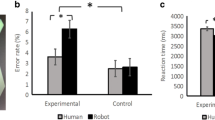Abstract
The BBC TV series Dr Who popularized the race of beings known as the "Daleks" [l]. A Dalek is a creature that is completely encased in a metallic shell, through which it can slide over the ground only over certain types of flat, smooth and electrically conducting surfaces. It has three limbs, one used as an eye-piece delivering a relatively small field of view, another which is a weapon, and a third which acts as an end-effector for the manipulation of objects. There is no direct evidence about Daleks’ auditory capabilities. However, this is unlikely to be good, since Daleks have a habit of repeating most things they say several times. Daleks tend to shout rather than talk, another indication of poor auditory capability and a lossy information channel. This evolutionary development was the result of a warinduced nuclear holocaust, thousands of years in the past.
Access this chapter
Tax calculation will be finalised at checkout
Purchases are for personal use only
Preview
Unable to display preview. Download preview PDF.
Similar content being viewed by others
References
Slater, M., Sadagic, A., Usoh, M., Schroeder, R. (1998). Small Group Behaviour in a Virtual and Real Environment: A Comparative Study. Presence: Teleoperators and Virtual Environments 9(1): 37–51.
Tromp, J.G., Steed, A., Frecon, E., Bullock, A., Sadagic, A., Slater, M. (1998). Experiments on Small Group Behaviour in the COVEN Project. IEEE Computer Graphics and Applications 18(6): 53–63.
Steed, A, Slater, M., Sadagic, A, Bullock, A., Tromp, J. (1999). Leadership and Collaboration in Shared Virtual Environments. Proceedings of the IEEE Virtual Reality Conference, Houston, TX, pp.112–115.
5. Frécon, E., Stenius, M. (1998). DIVE: A Scaleable Network Architecture for Distributed Virtual Environments. Distributed Systems Engineering Journal 5(3): 91–100.
6. Frécon, E., Greenhalgh, C., Stenius, M. (1999). The DIVEBONE - An Application-Level Network Architecture for Internet-Based CVEs. In Slater, M. (ed) Proceedings of the ACM Symposium on Virtual Reality Software and Technology’99, London, UK, ACM Press, pp 58–65.
Hardman, V., Sasse, M.A, Kouvelas, I. (1998). Successful Multiparty Audio Communication over the Internet. Communications of the ACM, 41(5): 74–80.
Leary, M. (1983). Social Anxiousness: The Construct and its Measurement. Journal of Personality Assessment 47: 66–75.
Kobayashi, H., Kohshima, S. (2001). Unique morphology of the human eye and its adaptive meaning: comparative studies on external morphology of the primate eye.Journal of Human Evolution 40(5): 419–435.
Kendon, A (1967). Some Functions of Gaze-Direction in Social Interaction. Acta Psychologica 26: 22–63.
Argyle, M., Ingham, R. (1972). Mutual Gaze and Proximity. Semiotica 6: 32–49.
Garau, M., Slater, M., Bee, S., Sasse, M.A (2001). The Impact of Eye Gaze on Communication using Humanoid Avatars. In Jacko, J., Sears, A, Beaudouin-Lafon, M., Jacob, R. (eds) Proceedings of CHI2001, Seattle, April 2001, pp 309–316.
Reiland, N. (1999). Acting the Part, Research/Penn State 20(1), http://www2.deasy.psu.edu/rps/jan99/acting.html.
Slater, M., Howell, J., Steed, A, Pertaub D-P., Garau, M., Springel, S. (2000). Acting in Virtual Reality. ACM Collaborative Virtual Environments, CVE2000, San Francisco, CA, pp 103–110. Also presented as a SIGGRAPH 2000 Sketch.
Waters, K. (1987). A Muscle Model for Animating Three-Dimensional Facial Expressions. Computer Graphics Proceedings (SIGGRAPH) 21(4): 17–24.
Rothbaum, B., Hodges, L., Kooper, R., Opdyke, D., Willford, J., North, M. (1995). Effectiveness of Computer Generated (Virtual Reality) Graded Exposure in the Treatment of Acrophobia. American Journal of Psychiatry 152( 4): 626–628.
Hodges, L.F., Rothbaum, B.O., Watson, B., Kessler, G.D., Opdyke, D. (1996). A Virtual Airplane for Fear of Flying Therapy. In IEEE 1996 Virtual Reality Annual International Symposium, Los Alamitos, CA, pp 86–94.
Schneier, F., Welkowitz, L. (1996). The Hidden Face of Shyness: Understanding and Overcoming Social Anxiety. Avon Books, New York.
Slater, M., Steed, A (1999). A Virtual Presence Counter. Presence: Teleoperators and Virtual Environments 9(5): 413–434.
Slater, M., Pertaub, D-P., Steed, A. (1999). Public Speaking in Virtual Reality: Facing and Audience of Avatars. IEEE Computer Graphics and Applications, 19(2): 6–9.
Reeves, B., Nass, C. (1998). The Media Equation: How People Treat Computers, Television, and New Media Like Real People and Places. Cambridge: Cambridge University Press.
Pertaub, D-P., Slater, M., Barker, C. (2001). An Experiment on Fear of Public Speaking in Virtual Reality. In Westwood, J. et al. (eds) Medicine Meets Virtual Reality 2001, IOS Press, pp. 372–378.
Pertaub, D-P., Slater, M., Barker, C. (2001). An Experiment on Fear of Public Speaking Anxiety in Response to Three Different Types of Virtual Audience. Presence: Teleoperators and Virtual Environments, in press.
Pertaub, D-P., Slater, M., Barker, C., Clark, D.M. (2001). The Responses of Phobic and Confident Public Speakers to a Virtual Audience. (in preparation).
Slater, M. (1999). Real People Meeting Virtually Real People - A Review of Some Experiments in Shared Virtual Environments. BT Technology Journal 17(1 ): 120–127.
Editor information
Editors and Affiliations
Rights and permissions
Copyright information
© 2002 Springer-Verlag London
About this chapter
Cite this chapter
Slater, M., Steed, A. (2002). Meeting People Virtually: Experiments in Shared Virtual Environments. In: Schroeder, R. (eds) The Social Life of Avatars. Computer Supported Cooperative Work. Springer, London. https://doi.org/10.1007/978-1-4471-0277-9_9
Download citation
DOI: https://doi.org/10.1007/978-1-4471-0277-9_9
Publisher Name: Springer, London
Print ISBN: 978-1-85233-461-1
Online ISBN: 978-1-4471-0277-9
eBook Packages: Springer Book Archive




